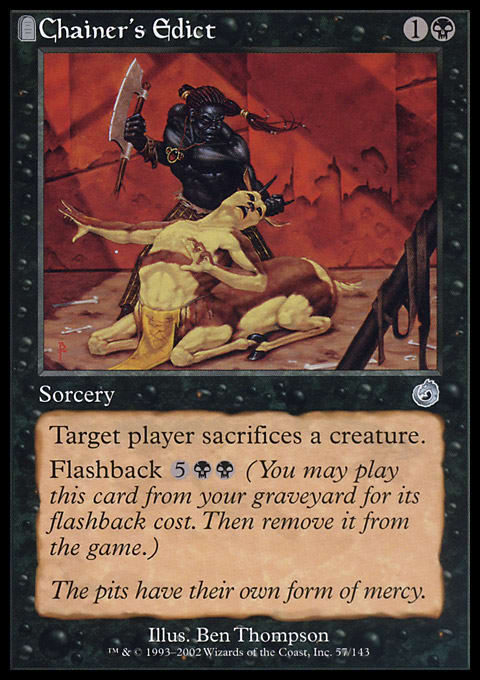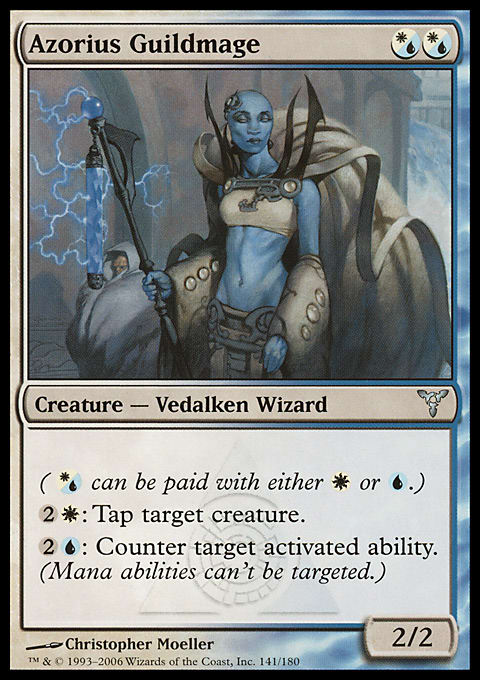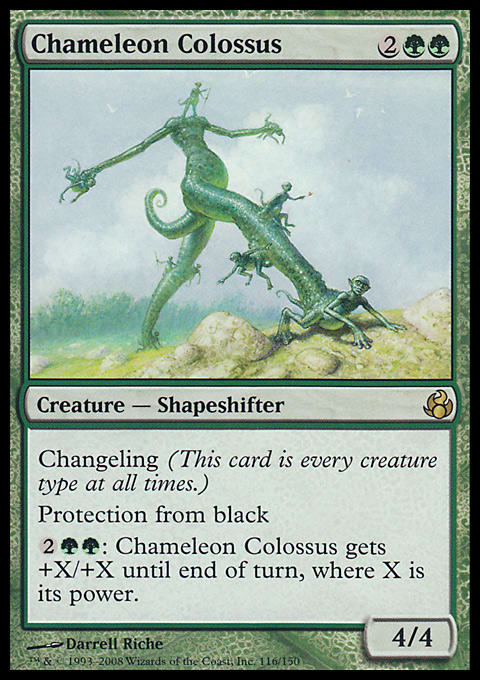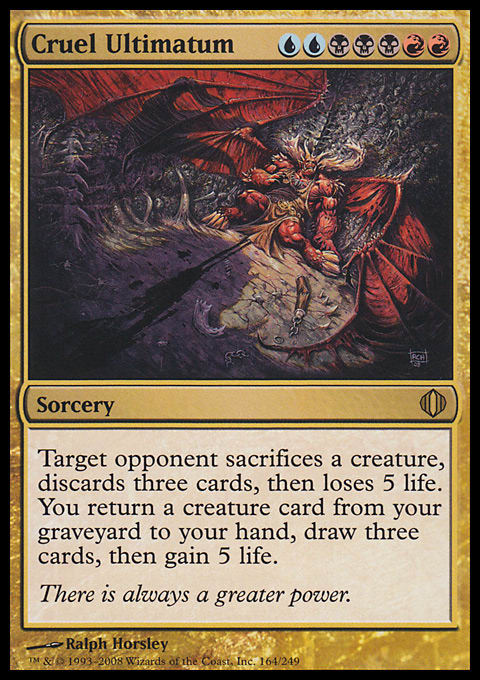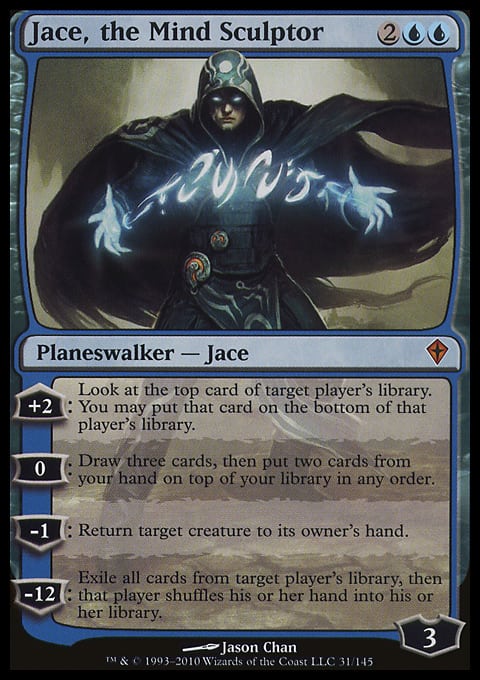Last time, I was only able to make it through about half the cards in my trip down From the Vault: Twenty memory lane, but we hit a strange part in my time with Magic: the time I quit.
I missed a whole bunch of stuff from Urza’s block right up until Judgment for a variety of reasons. But since I’m here today writing these words on this Magic website (as well as Wizards’s official coverage), the fact that I came back to the game isn’t much of a surprise.
How I came back, well, that’s our next story . . .
Chainer's Edict (2002) and Akroma's Vengeance (2003)
Chainer's Edict represents the very last set before my miraculous, and this time permanent, comeback to the game of Magic. I missed the releases of both Odyssey and Torment, but I was drawn back in right around the time Judgment was released.
It started slowly—reading a few Magic websites, keeping up with Scrye and InQuest, following a few tournaments. My mind was never very far from the game even if my money and my time were.
But there was always that itch, that temptation, that indescribable thing that pretty much anyone who plays the game feels when he or she goes for some time without playing. Maybe it’s addiction. Maybe I’ve substituted Magic for another drug. Maybe I just like games.
Whatever it was, that itch caught up with me while I was in a video game store visiting a friend who worked there. They had Magic, and the latest set Judgment seemed pretty cool from what I had read. So, I bought a few packs.
Somehow, in the three packs I purchased, I was gifted with two copies of Anurid Brushhopper. Now, this card was never a powerhouse, and it certainly hasn’t done anything in Eternal formats (even though its effect is fairly unique, its casting cost is palatable, and its combination with Balance and Balance-like spells impressive), but it instantly caught my fancy, particularly with this new Akroma's Vengeance I had heard so much about (which brings us to the next card on the list, coincidentally).
So, I set about buying back my collection, which was fairly simple, as the cousin I had sold it to had grown bored of it. I repaid exactly what I had paid without checking the contents, and I went on my way.
Boy was I in for a surprise.
My cousin had clearly done some trading. And he was not good at it. Most everything that would today be worth quite a bit was gone. Force of Wills? Gone. Wastelands? None to be found. Balduvian Horde? Still there, actually.
So, my collection was a shell of its former self, which left me little to trade with and even less to play with. So, those initial Anurid Brushhoppers would form the backbone of a deck I would play extensively.
The deck was a G/W concoction (naturally) with Wraths, Akroma's Vengeance, Anurid Brushhopper, Krosan Verge, and the underrated Deftblade Elite, which I would use as Elf and Goblin removal early or a veritable Fog late. The deck was actually pretty good.
I played it in a few local tournaments, did well, and, obviously, kept going. But if it wasn’t for a certain Frog Beast and Akroma's Vengeance, that might never have been the case.
Gilded Lotus (2004)
Gilded Lotus will forever be all about Commander/EDH to me. And since we’re in an article about nostalgia, I’m going to call it EDH like the old man that I am.
I don’t have any particular stories about Gilded Lotus except that it’s been a key part of virtually every EDH deck I’ve ever built, including my first ever: Rubinia Soulsinger. It’s a deck I still have today.
Back then, it was all about combos, particularly with Gifts Ungiven. There was Fastbond/Crucible of Worlds/Zuran Orb/Strip Mine/Glacial Chasm, Reveillark/Body Double, Mana Reflection/Grim Monolith, and more. It was a work of art that absolutely no one wanted to play against. Then, they banned Gifts Ungiven and Fastbond, and the deck shifted. It has continued to evolve over the years (it’s currently planeswalkers and Doubling Season plus value cards and don’t-kill-me cards), but it has always, always, always featured Gilded Lotus.
Ink-Eyes, Servant of Oni (2005)
It was Regionals around the time of Champions of Kamigawa/Ravnica: City of Guilds. My friends and I were putting in some actual testing (for once) and had a number of decks we liked. Wildfire was performing well, as were Heartbeat of Spring–based combo decks. We knew Heartbeat would be everywhere, and knew we needed to be able to beat it.
That was when I stumbled across a little gem called Azorius Guildmage. The card never saw much play, but her abilities, I found, were oddly relevant. Tapping creatures could be powerful with Keiga, the Tide Star and Yosei, the Morning Star running rampant, but it was the second ability that caught my eye.
“Counter target activated ability.”
For those who don’t know, the Heartbeat combo decks relied heavily on transmute as a way to find its combo pieces. Transmute, usually uncounterable, was actually an activated ability. One Azorius Guildmage could, in theory, completely shut down the Heartbeat deck’s tutor engine.
But that also meant keeping mana up, which meant I needed something to do with that mana. Counterspells, especially Remand, were the first choice. The second, I decided, would be Sunforger, a card that let me search out Lightning Helix and, in a brief fit of insanity/genius, Hidetsugu's Second Rite.
You see, the deck was good at stymying the early game, but bad at actually dealing 20 damage. It could do 10 damage pretty well, usually helped out by some shock lands and some pain lands (like Adarkar Wastes). It was gimmicky, but good enough that I ran with it. Back then, I preferred creativity to winning, though I usually attempted to do both.
And for five rounds, it worked wonderfully. I started off undefeated, and word was spreading that someone was playing Hidetsugu's Second Rite and killing people with it. I killed both of my first two opponents with it twice, setting it up in both games. The deck was difficult to pilot, but the results were paying off.
And then I was paired against a weird kid whom people were telling me was good but who had a pretty random deck. I hadn’t ever heard of him before, though others who knew the Midwest PTQ scene better than I did said he was a regular. I remember his nails were long.
We sat down and introduced ourselves. “Hi, I’m Blake,” I said.
“Hey, I’m Sam.”
As in Sam Black.
Granted, back then he wasn’t Sam Black, but I remembered the match distinctly because of what followed.
He was playing a B/G/W deck with a ton of one-ofs, such as one Yosei and one Greater Good (I think) held together by Farseek and a bunch of awesome legends. One of those legends was Ink-Eyes.
Now, before the tournament, we had spent some time going over a list of things Azorius Guildmage could counter. One of those things, because it was actually an activated ability even though it didn’t feel like one, was ninjutsu.
Still, in a moment that dashed my brewing and tournament hopes all in one fell swoop, Sam ninjutsu’d in an Ink-Eyes while I had both the mana and the Guildmage to counter it.
Instead, I just let it happen. As a result, I lost.
I was crushed—so much so that I kept bad hands and blundered my way through a Heartbeat matchup I should have been favored in but instead was crushed in. Then, I played against a literal land-destruction deck and was crushed.
I actually brought this story up to Sam at Grand Prix Atlanta, where he made Top 8 with Goblin Bombardment. And, amazingly enough, he remembered the game clearly, even going through his deck and his thought process. I’ve never doubted him since.
I’ve also never again picked up an Azorius Guildmage despite its Commander applications.
Char (2006)
I have never and will never play with this card. Maybe when it was called Psionic Blast . . .
Venser, Shaper Savant (2007)
This isn’t so much of a story as how awesome it is that I was able to pick one of these up for $15 this past weekend for my Azami, Lady of Scrolls deck that I’m foiling out at a glacial pace. I really love this new art.
As for the card when it was legal, I mostly played it alongside Momentary Blink and Reveillark. Using this, Body Double, and Mirror Entity to bounce all of my opponent’s permanents is exactly the kind of Magic I love (and other people vehemently hate). If I could figure out how to mitigate Deathrite Shaman, there’s a very good chance I would be playing something similar in Modern—might anyway.
Venser was also part of the first tournament where I helped out with coverage: U.S. Nationals in 2007. You’ll find my name proudly listed as “Staff” since I mostly just helped type up decklists and all that. I was paid handsomely with a box of product (and, at the time, I actually remember thinking it actually was a handsome reward).
My first Nationals byline wasn’t until the next year in 2008 . . .
Chameleon Colossus (2008)
While Colossus didn’t play a big role in my experience for that Nationals tournament, it certainly played a big role in the actual tournament, which Michael Jacobs won.
Looking back at the coverage of U.S. Nationals 2008, I’m actually shocked by not only how many coverage guys we had (five or six . . . we now use two-man teams) writing stories, but how nearly every one of them is still going. Bill Stark works for Wizards, Nate Price, Marc Calderaro, and I are all still on the text team, and Brian David-Marshall is still, well, Brian David-Marshall. Only David Strutz hasn’t continued.
Marc and I were both newbies back then, but Bill and Nate were fairly well-established in coverage back then. To see them still working with Magic (Bill no longer does coverage since he’s an actual Wizards employee) is quite impressive. It just goes to show how addicted we all are.
Cruel Ultimatum (2009)
I probably cast Cruel Ultimatum as much as any human being on the planet from the moment it was released until the second it rotated. But one particular tournament stands out.
It was States, and my friend Tyler and I had been working on a deck we called Super Amazing 3-Drop Fantastic for reasons that are still unknown. The deck was, essentially, a five-colored, all-cascade deck that played three 3-drops that it cascaded into every time: Esper Charm, Kitchen Finks, and Maelstrom Pulse (with Volcanic Fallout in the sideboard). Those three cards just happened to be pretty good against Faeries, as was the actual cascade mechanic.
That deck did all of those things, up to and including Enlisted Wurm, pretty much the best card in the deck, as a way to set up Cruel Ultimatum. Sometimes, we played Baneslayer Angel as a random 5-drop because it was just that good, but otherwise, it was all cascade spells, 3-drops, and Ultimatums.
Come States, however, I chickened out. Remembering the Azorius Guildmage example, I went safe and played straight Cruel Control. Tyler played Super Amazing 3-Drop Fantastic. I was out by Round 4. He, playing my deck, went deep into the tournament.
The thing was, even though I liked the Azorius Chancery deck, I was never sold on it. However, I knew the Cascade deck was good, but I bailed anyway. Since then, I’ve learned to listen to myself when I just know something—even if that something involves casting Captured Sunlight.
Jace, the Mind Sculptor (2010)
I can almost certainly say that I played a small part in having Jace, the Mind Sculptor banned—a tiny role, and probably inconsequential, but that’s not really how I saw it at the time.
Like Chameleon Colossus, this memory randomly involves Michael Jacob—because of course it does.
It was Grand Prix Dallas/Fort Worth in 2011, one of the last events where the Jace Father was legal. While the format seemed relatively wide open for the first part of the weekend, as we went on, it was anything but.
I was doing metagame reports as the tournament went on, and the pattern emerging was blindingly obvious: R/U/G and Caw-Blade, two Jace decks, were exceedingly taking over the top tables. Others were scattered throughout, but as time wore on, those two decks took up more and more space.
Then, the Top 8 turned out to be four R/U/G decks and four Caw-Blade decks. Seizing on this, I split the Top 8 photo into two groups—the R/U/G players and the Caw-Blade players—and started forming a narrative where it was R/U/G versus Caw-Blade for Jace supremacy. We carried that narrative through the end of the tournament, and, not coincidentally, Jace was banned soon thereafter.
Granted, that change was going to happen anyway, but I like to think the way we framed the story might have been something of a shock to the system.
Green Sun's Zenith (2011) and Kessig Wolf Run (2012)
I’ve run out of space and, coincidentally, stories! Since I’ve never cast or activated either of these cards in a sanctioned match (though I was there for Junya Iyanaga’s 2011 Words victory from which Zenith was pulled), and neither of these cards resonates with me deeply, I’ll just end this opus here.
In the meantime, share your stories in the comments or check out the feature I did at Grand Prix Oakland last weekend, where I asked the pros what their favorite and most resonant cards from FtV: Twenty are.
Thanks for reading, and here’s to twenty more years.
















